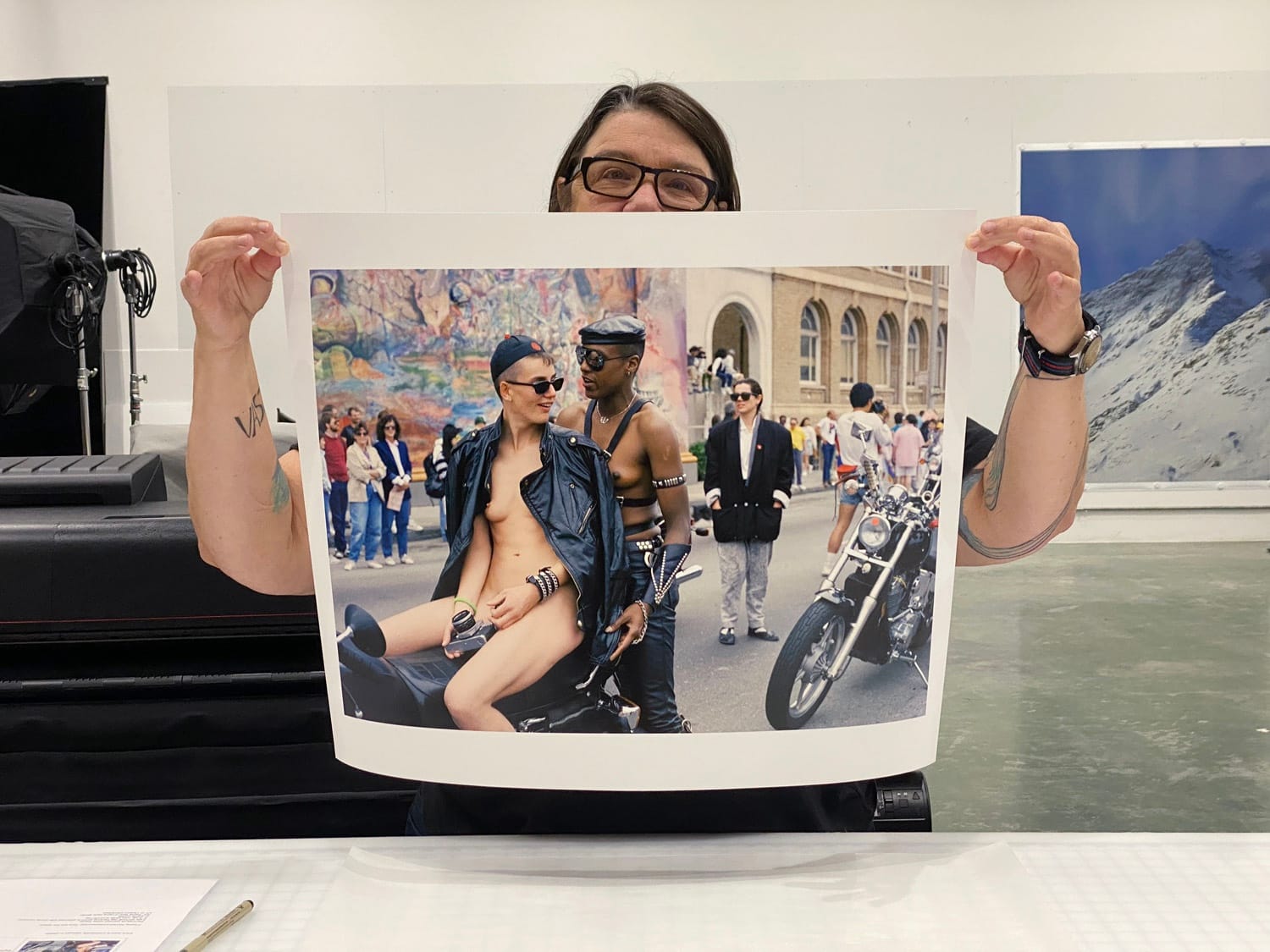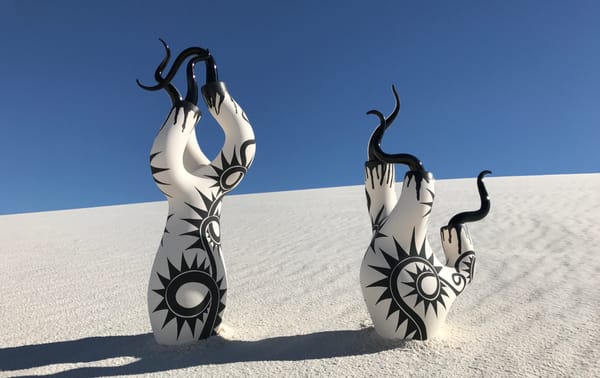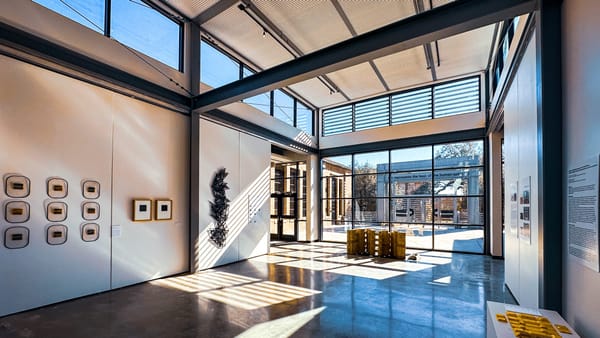Catherine Opie’s Unrelenting Fight for Visibility
From street snapshots to resplendent studio photographs, the artist draws us powerfully into her life-long project of bearing witness to her community.

This article is part of Hyperallergic’s 2024 Pride Month series, featuring interviews with art-world queer and trans elders throughout June.
The year is 1990 and the scene is the San Francisco Pride Parade. Two women are perched on a motorcycle, one of them straddling the seat, nude except for a black biker jacket draped around her shoulders, the other mounted pillion-style, a leather harness strapped across her chest. When Catherine Opie snapped the shutter, she captured more than just the closeness of their body language; the flicker of their gazes filtering through tinted sunglasses; or the camera cradled suggestively between the woman's thighs, the discordant flash of green of the scrunchie on her wrist. The photographer, now 63, also seized on something intangible: a moment of queer chemistry and sensuality.
The photo, a limited-edition print of which is being sold this Pride Month partly to benefit the Callen-Lorde LGBTQ+ health organization, was "real street photography," Opie reminded me in our conversation — distinct from the resplendent studio portraits of queer individuals for which she's best known. Whether in a quick snapshot or a posed picture reminiscent of a Renaissance painting, she draws us into her project of "bear[ing] witness to my own community," as she puts it. Read our interview, which took place over the phone, below.
* * *

Hyperallergic: I want to start by asking you about this photo, "Gay Pride, 1990." What do you feel when you look back to that time and think about the celebration of Pride today?
Catherine Opie: This image was real street photography. It was the Pride parade in San Francisco, and that specific print is about the joyousness of being out and what it is to be gay. I love that the camera is in between her legs as well: It's like, she's looking, I'm looking, we're all looking, we're all responding to the politics of the moment. It's this very kind of prideful, joyous moment of acknowledgment of these two very sexy women together.
The hardest thing about Pride in 1990 was how much loss we had gone through with AIDS. Pride was still about joining together, being a political force, being bodies on the street, you know, having a presence. We had Reagan basically not even acknowledging AIDS, [Republican Senator] Jesse Helms holding up Robert Mapplethorpe photographs in Congress. So one of the things I love about that image is that it could still be today. That could very easily be right now — we still have to be out, we still have to be visible. We're also living in incredibly fraught times in relationship to laws and politics. We have a national warning advisory around pride for gay and lesbian and trans folks. It's crazy. But we're still trying to go forward and celebrate with visibility, and I just feel like that's a very powerful, optimistic place to try to be in.
H: Do you feel, in your experience, that the art world has become more accepting? As a person in the art world who is queer, have you seen that change over time?
CO: I've always felt very accepted in the art world to a certain extent. I've felt very fortunate to have been out, and that as out as I've been and as bold as I've been, I've been able to achieve an international audience. I never thought I would be able to be this honest and actually have people follow along. But I would say that the arts are a bit of an island and incredibly liberal for the most part — there is permission for that kind of honesty, and that's not the case in all fields. I mean, look at the assault on public libraries: states banning certain books so that children don't read about gay people. It's outrageous. Artists have a lot of permission still, but that doesn't mean that there aren't crazy assaults on our ideas and what gets shown and doesn't get shown.
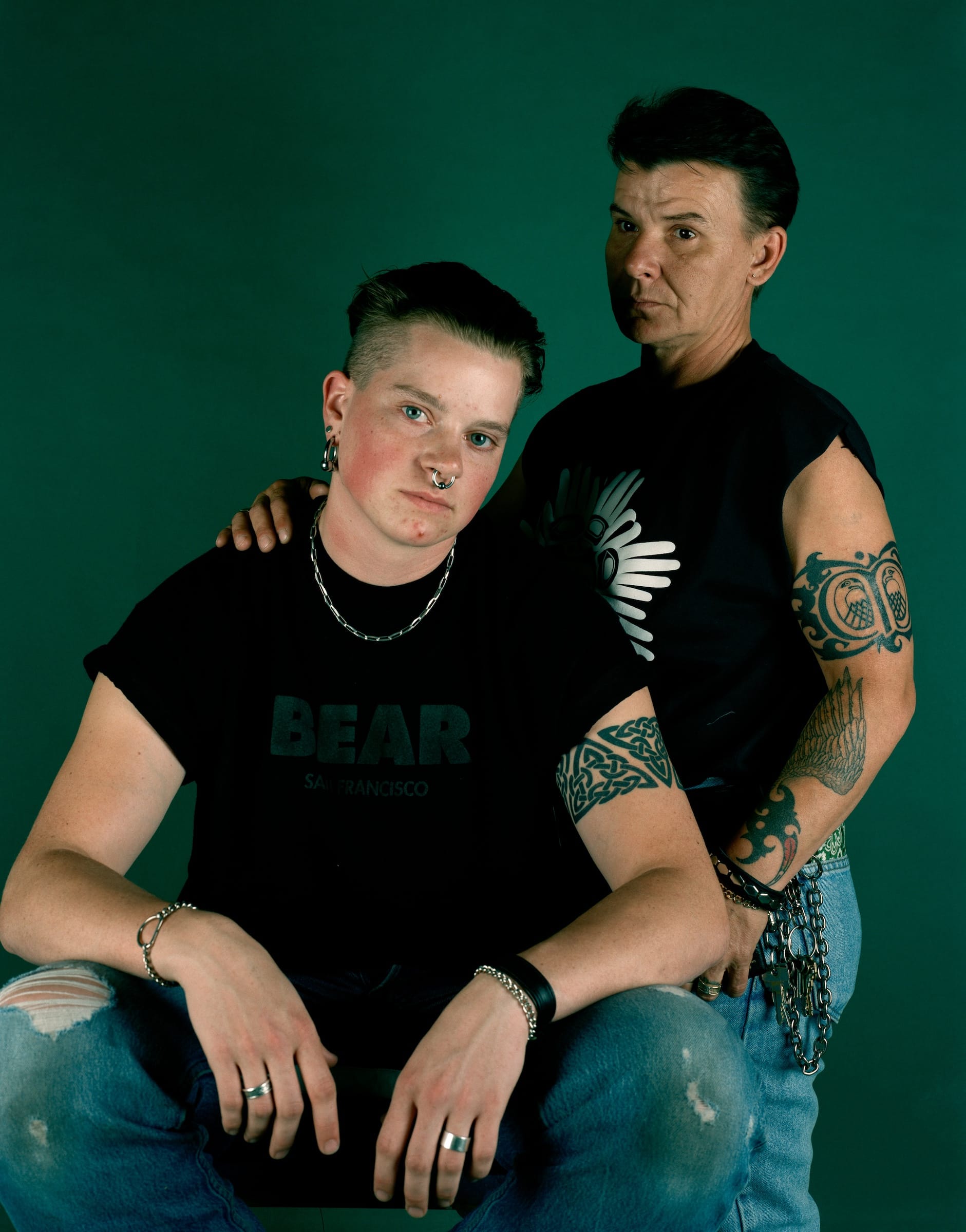
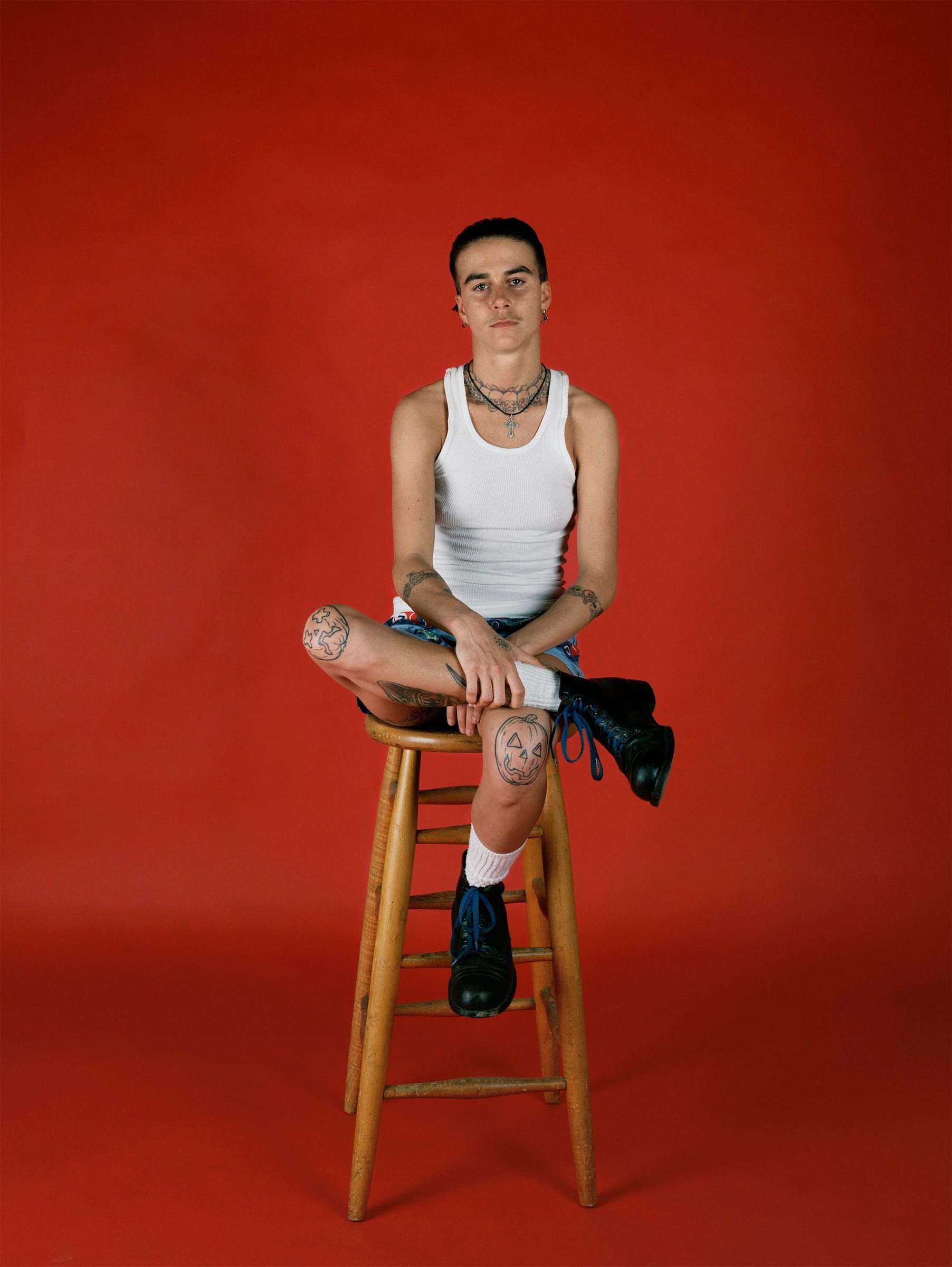
H: Are you able to speak on your experience of coming out and what that was like for you at the time?
CO: Well, yeah, it was hard. I mean, it was scary. I remember even just walking down the street in Poway [California] — and I've always been a tomboy and butch — and people calling me a dyke or throwing beer cans at me, and the fear that harm could come to your body because of being too out. I moved to San Francisco in the early ’80s and I got to be within this incredible community of amazing thinkers and to have influences like Pat Califia and Dorothy Allison and Gayle Rubin, and be brought into the leather community. So I was in a place where I could explore these ideas without thinking that I could potentially be killed and tied to a fence, like in other places in the country. But that doesn't come without an incredible price of trying to face internal homophobia and what it means to be visible, and to be visible within your art. All of that is brave. It's hard.
H: You mentioned some of your early influences — did you have any queer mentors? Were there artists you saw as role models?
CO: I think it was a community of writers first, people like Allison and Califia, and also Sarah Schulman and the Barnard Conference [Towards a Politics of Sexuality, 1982], in terms of feminist writers. Besides artworks, words — and reading the brave people who put ideas and complicated, honest thoughts down on paper — were my first mentors in a certain way. They allowed me to think, well, I don't have language in that way, but my language is photography.
H: I read a quote in which you discuss your early portraits, and you say you were looking to create "dignified" images. Can you tell me more about that?
CO: One of the things that was so interesting was the over-sexualizing of the queer community — with Mapplethorpe, it was titillating in that way, and I certainly did that with early erotica work. But when I was thinking about dignity, it got to the point where, especially with so many of my friends dying from AIDS, I didn't want to have queerness or the representation of being queer only be related to a sexual exploration of eroticism. And so by making portraits of people in which they were sexy in their bodies but really present with the camera, and using brightly colored backgrounds as a reference to traditional portraiture that people knew through the history of painting, it automatically created a specific dignity within the person, because of the formality of the portrait. So it wasn't body parts, it wasn't just nipples or, you know, whips up asses or things like that — which I love, which I think are awesome, and I'm glad they exist — but it was also, with so much loss, what does it mean to bear witness to my own community and begin to talk about our bodies and what's going on?
H: I see that dignity in the self-portrait you made in the early 2000s, where you're breastfeeding your baby.
CO: Yeah, with Oliver, "Self-Portrait/Nursing." That's me and my boy. Who just graduated from college.
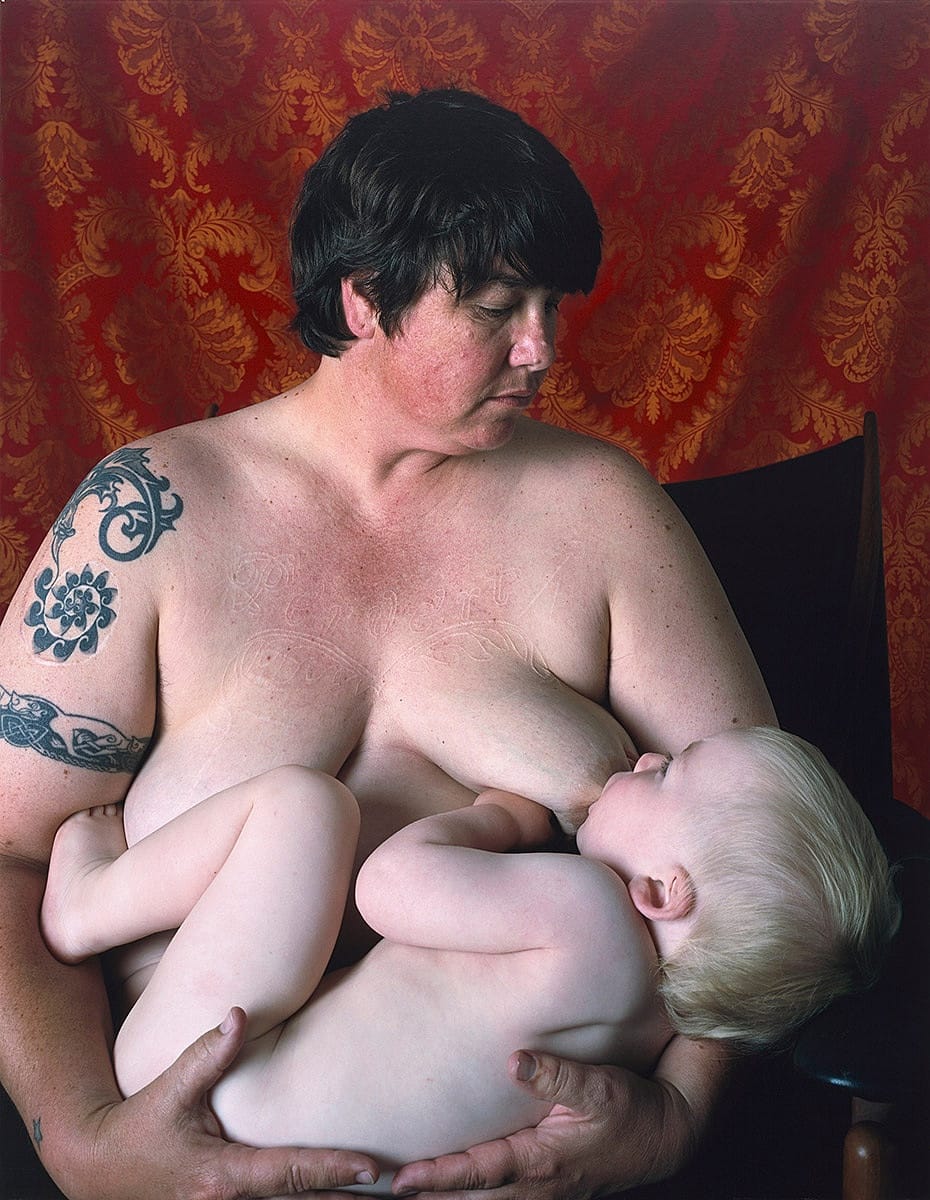
H: What do you think about the commodification and appropriation of Pride by corporations in recent years, has that also contributed to a distorted idea of LGBTQ+ individuals?
CO: I think we need all our allies. If people wanna slap a rainbow flag on a box of Wheaties during the month of June, hell, I'll buy it. What the hell, you know? Any kind of visibility or advocacy that is positive is hopefully only going to create more allies versus more harm. Do I want the commodification of queer culture? No, but we live in a completely global capitalist society in which everything is commodified. So I'm just pro more allies. Let us have some allies.
H: Are there any new projects you're working on that you're excited about?
CO: Oh yeah, there's a really exciting show that's going to happen in Brazil at MASP [Museu de Arte de São Paulo], the incredible museum designed by architect Lina Bo Bardi. On July 4, I'm opening a show of 70 portraits that will be installed with their Old Masters collection on the original Bo Bardi plinths, with Rembrandt and Holbein and Titian, curated by Adriano Pedrosa and Guilherme Giufrida. It's interesting — there was a huge protest against Judith Butler at MASP that prompted this other kind of exploration about gender for her in her latest book. Queer content is very fierce within the exhibition, it's prominent, because that's the theme this year at MASP. And I'm really curious to see how that will get read in Brazil.
